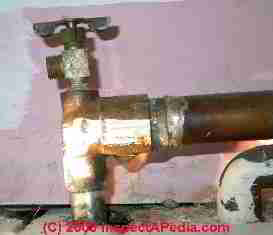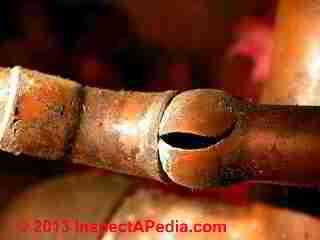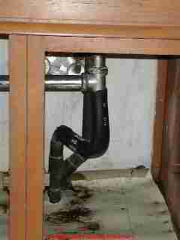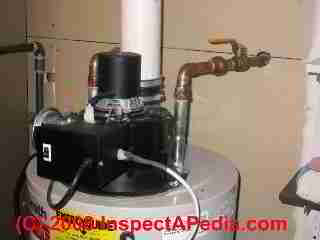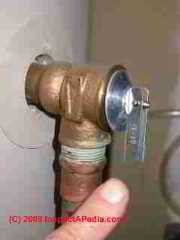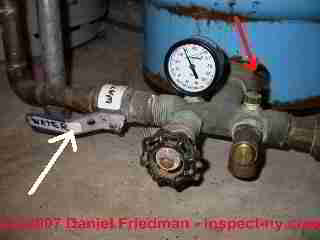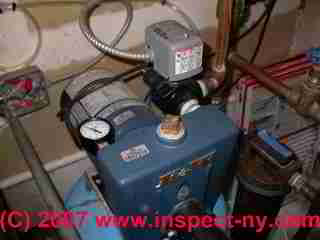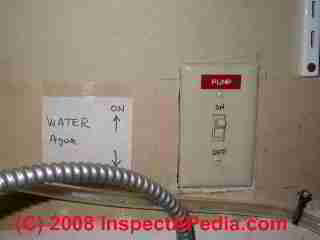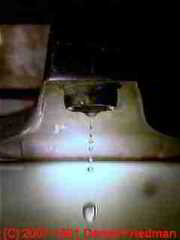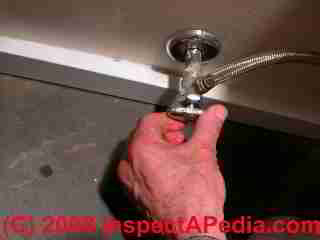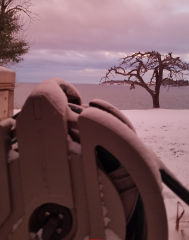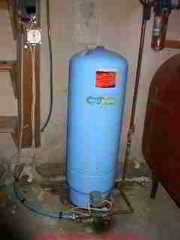 How to Turn Water Back on in a Winterized or Shut Down Building
How to Turn Water Back on in a Winterized or Shut Down Building
- POST a QUESTION or COMMENT about how to de-winterized a building that has been shut-down: procedures to avoid water damage and leaks
How to turn the water back on at a building when water has been left off for winter or for repairs.
This article explains how to turn the water back on in a building that has been previously winterized or shut down. When de-winterizing a building, which includes restoring its water supply, there is a risk of surprise leaks. We explain what to do to prevent or at least minimize any building damage.
The articles in this series will answer most questions about freeze protection for piping and other building plumbing and heating system components: how to winterize a building to avoid frozen pipes, and how to thaw frozen water supply & drain piping, wells, & water tanks.
InspectAPedia tolerates no conflicts of interest. We have no relationship with advertisers, products, or services discussed at this website.
- Daniel Friedman, Publisher/Editor/Author - See WHO ARE WE?
Staged Steps in Turning on Water Supply System to Minimize Water Leak Damage in buildings
We recommend and will describe here a staged step by step approach to turning on water in a building where the water supply has been shut down over a winter or during a period of absence.
The staged approach lets us check each building area and fixture one by one, minimizing the chances of extensive water damage even if a leak has occurred while the building was unattended.
Even for buildings located in areas not subject to freezing and burst pipes, a staged water turn-on approach is useful. A pipe may have been damaged or cut by building activities, a trap may have corroded through, or other plumbing damage may be present even if no freezing conditions occurred..
Step 1: Repair any supply piping or drain leaks found by visual inspection
The photos above and below show two visually obvious water supply pipe leaks that need to be repaired before hot water heating (above left) or water supply (above right) can be turned on in this building.
Watch out: Don't turn on the water supply before any known cut or broken pipes have been repaired.
Well this is not exactly true. You may think that all cut or broken pipes have been repaired and then try turning on the building water supply only to find that there was a leak that you simply wouldn't see until you turned on water and saw the leak. But inspect what you can of all accessible pipes to minimize the risk of a big surprise leak.
Step 2: Repair any drain piping leaks found by visual inspection. Replace any open or damaged plumbing traps
Don't turn on the water supply before you have also restored the drain piping system including all fixture traps.
As you are checking and replacing plumbing traps at sinks and at showers or tubs where the traps were removed for winterizing, check for and replace any traps that are corroded or in poor condition.
Making this repair now will head off troublesome drain leaks later.
If you find faux-plumbing traps such as the one in our photo (left) made from a car radiator hose, install a proper P-trap and plumbing fittings instead.
The drain piping shown is unsafe because it lacks a water trap to prevent sewer gases from backing up into the building; stains on the floor of the sink vanity show us that we have had a history of leaks at this drain as well.
Step 3: CLOSE all faucets indoors and outside. Turn OFF hot water. Turn OFF other water supply shutoff valves
Closing every faucet makes sure that you can open and check each fixture individually without being flooded by leaks in one area of a building while you're checking somewhere else. Don't forget to close outside hose faucets as well as all indoor faucets.
If the building was winterized and pipes drained, chances are that all faucets and valves were left "open".
Don't turn on the water supply before closing all supply piping drains that were left open.
Check & close the water inlet valve at your water heater
and turn off the inlet valve on the cold side - which should be the only valve at the heater (valves on both inlet and outlet pipes are unsafe and risk a heater explosion).
This is a convenient spot to turn off all hot water supply in the building - a step that lets us first test the cold water supply piping for leaks before moving on to checking hot water supply piping.
Our photo (left) shows that the yellow water heater shutoff valve is in the "open" position and needs to be closed for the procedure we are discussing.
Check the water heater pressure/temperature safety valve:
If the water heater has a manual lever that opens the water heater pressure/temperature relief valve, make sure that safety device has also been closed to its normal position before turning on building water.
Our photo (left) shows a pressure/temperature relief valve on a gas-fired water heater that is in its normal, "closed" position.
The relief valve is sometimes left "open" with the metal lever pointed "out" or in the horizontal position to hold the valve in the open position when a water heater tank is being drained. That step lets air into the tank so that water can run out of the tank. If the heater valve is not returned to the closed position water will simply run out of it when the tank is re-filled.
Unless you're a plumber and have a spare relief valve on hand it's best to leave this valve alone.
Close building plumbing supply pipe area shutoff valves:
First, if the building has additional water supply control valves that shut off water to various building areas, let's close each of them so that we can later open them one by one. If the building was winterized in a freezing climate it is likely that all of these valves were left open to drain piping earlier.
If you cannot close an old corroded water shutoff valve,
don't force it as you may break it and cause a worse problem. Just add this valve to your list of necessary plumbing repairs.
Step 4: Turn ON the building water supply at the main valve
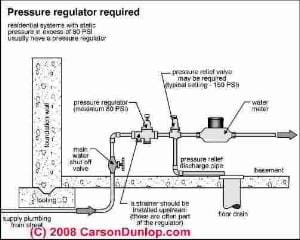
Municipal or community water supply
if your water is supplied by a municipal water main, turn on water at the main water shutoff valve.
Look for leaks at the water shutoff valve itself, then look and listen for other leaks as we describe in more detail below.
Stop, look, and listen for leaks at the water main valve or water pump and water tank.
Also look and listen for leaks in the supply piping nearby.
Private well and water tank systems: if your water is supplied by a private well take these additional steps:
Turn off the water shutoff valve at the water tank. This is the valve that lets water out of the water tank to supply the building piping. Most water pressure tanks will have only a tank outlet valve between the tank and the building water supply piping.
In our photo the water valve at the bottom of this pressure tank is in the "open" position - the the handle is parallel to the pipe.
For the procedure we are starting here, this valve should have been left in the up or closed position.
Make sure any valve between water pump and water pressure tank inlet is in the open position:
But some systems include an additional shutoff between the water pump and the inlet to the water tank.
If this valve is shut and the pump turns on, depending on just where the pump pressure control switch is installed, the pump may short cycle on and off rapidly or it could even be damaged or burst a part or pipe - a dangerous condition. Make sure that any valves between the water pump itself and the water tank inlet from the water pump or well are in the open position.
Do we need to prime the water pump?
If the water pump is above-ground in the building or in a well pit, the pump may be dry and it may need to be primed through a priming inlet port on the pump itself.
Our photo (left) shows a two-line jet pump that will need priming through its top plug if it was drained and left dry during building shut-down or winterizing.
If building water is supplied by a private pump and well system, you may need to bring along water to re-prime the well pump.
Don't let a well pump run "dry" for more than 30 seconds or there is risk that you will damage the water pump's impeller, bearings, or other internal parts.
If the water pump is a submersible unit, it is located in the well pipe and under-water - it does not need to be primed.
Turn on the water pump.
The pump should turn on, pressurize the water tank, and turn off.
If the pump turns on but does not turn off check that the shutoff valve supplying water to the building is indeed closed - otherwise your system may be pumping water out of an open faucet or a leaky burst water pipe.
If you are having other problems with the well pump not turning on, not turning off, or not reaching a normal water pressure, see the diagnostic articles
at WATER PUMPS & TANKS
and WATER PRESSURE LOSS DIAGNOSIS & REPAIR.
Stop, look, and listen for leaks at the water main valve or water pump and water tank.
Also look and listen for leaks in the supply piping nearby. If there were no other shutoff valves to individual areas of the building, look and listen for leaks in supply piping throughout the building before continuing to check individual plumbing fixtures (Step 6-below).
Of course if you detect a leak in the water supply equipment, tanks, or piping system turn the water supply off immediately and remove any spills before starting the leak repair.
See LEAKY PIPE REPAIRS
Step 5: Open water shutoff valves that supply water to each individual building area, one by one
If multiple water valves were turned off during building shut-down, open them one at at time, checking for leaks in each individual individual building area before continuing.
If your building is simple, with just a few areas where plumbing pipes and fixtures are present you can omit some of the detailed steps we describe here, look for leaks, and proceed to Step 6.
Stop, look, and listen for leaks at the water supply piping and fixtures
in each individual building area supplied by the water valve you have opened.
If the individual plumbing fixtures such as toilets and sinks have individual hot and cold water shutoff valves, those are usually left in an "open" position unless someone already knew that the fixture was leaky.
Our photo (left) shows a dripping faucet. This will be a lower priority leak repair than a leak in a supply pipe because the drip sends water into the building drains, not into the building walls, ceilings, or floors - provided that the drain pipes are also not leaking.
Step 6: Turn on and test individual plumbing fixtures - brief test
Once you are confident that there are no obvious leaks in any of the building supply piping, test each individual plumbing fixture for operation by opening its faucet, first cold, then hot water; look for functional supply and drainage, but run just a quart or so of water first, checking that the fixture trap is not leaking.
Our photo (left) shows a toilet supply valve being turned back on to test that fixture.
Stop, look, and listen for leaks.
Do not leave after turning water on at a previously winterized or shut-down building before you have spent some time looking and listening for leaks, including the hiss, spurt, or just drip of a water supply pipe that may have burst hidden in a wall or ceiling cavity.
Step 7: Drain leak test: full water test at each plumbing fixture
Once we have seen that the sink and tub traps are not leaking, go ahead and use the plumbing fixtures normally. When several gallons or more of water have been run into a fixture drain, check for visible leaks or sounds of dripping from the building drain piping.
Some slow leaks in supply piping or drain piping are harder to detect - we describe these at Water Supply/Drain Pipe Leak Types.
Stop, look, and listen for leaks.
Watch out: Do not leave after turning water on at a previously winterized or shut-down building before you have spent some time looking and listening for leaks, including the hiss, spurt, or just drip of a water supply pipe that may have burst hidden in a wall or ceiling cavity.
...
Reader Comments, Questions & Answers About The Article Above
Below you will find questions and answers previously posted on this page at its page bottom reader comment box.
Reader Q&A - also see RECOMMENDED ARTICLES & FAQs
On 2020-04-03 by Gayle - What does the temperature need to be before turning on the water in a cabin?
What does the temperature need to be before turning on the water in a cabin.
Does the ground need to be thawed or does the evening temperature need to be above freezing? I live in Minnesota
On 2020-04-03 16: - by (mod) - when is it safe to turn on water to a seasonal cabin in Minnesota? Consider the Frost Depth !
Hi Gayle.
The answer to "when or at what temperature is it safe to turn on water to a cabin in Minnesota" is
... it depends ...
- on where in Minnesota your cabin is located and the frost depth and temperatures in that area, including whether or not there was deep snow cover that reduces the frost depth
- on the depth to which your water pipes to your cabin are buried; if pipes are in the top foot or so of soil, then that soil warms first when outdoor temperatures are above freezing while pipes deep in soil will require more warming and soil defrosting
Up in Hibbing or in Embarrass MN where temperatures are coldest, the frost level in the soil may reach 6 to eight feet in depth. Even when it is above freezing outdoors, it may take a few weeks or longer for soils to warm enough that water sitting in a water supply pipe won't freeze solid.
Up in Two Harbors we put out garden hose hookups two days ago (April Fools Day as you'll see below) as temperatures are hovering in the mid 30s at night. But this location (photo below) is right on the big lake where temperatures are more moderate than further inland.Watch out: April Fool! As you can see from our photo just below, weather and freezing conditions in northern Minnesota can change quickly.
Just one day after our first photo of our newly-connected outdoor garden hose, this site had freezing weather and new snow-fall.
Just below I'll add some technical data on frost depths across Minnesota, though unfortunately we don't yet have that data for 2020.
The depths I gave earlier are for typical water piping in Minnesota, where well drillers and plumbers take care to place water lines *below* the greatest expected frost depth.
If your cabin has a drain-back water system that removes water from its supply piping after use then, of course, you can turn on water with impunity.
The FROST DEPTH in MINNESOTA (to 2018) [PDF] gives us data of frost depth and thaw times across the state, found at InspectApedia.com at
but take care: the DNR has not yet posted soil frost depth data for the current winter of 2019-2020.
Adding snow, temperature and frost data for Minnesota for 2020
"Minnesota lakes, rivers, and wetland complexes continue to be ice covered. In general lakes first froze over in early December. Lake and river ice is never completely safe.On March 4, Lake Superior was 6.3% covered by ice, a much lower percentage for this date than last year. In early March 2019, Lake Superior was 93.5% covered by ice.
The maximum ice coverage for Lake Superior typically happens in late February."
"The March temperature outlook indicates a high likelihood for above normal temperatures. Normal March high temperatures climb from near 30 degrees early in the month to the low to mid-40s by month's end.Normal March lows begin the month in the single digits above zero in the far north and mid-teens in the south. By late March, normal lows are in the low 20s in the north, near 30 in the south."
- retrieved 2020/04/03, original source: MN DNR https://www.dnr.state.mn.us/hydroclim/hydroclim-minnesota-early-march-2020.html
Bottom line: if your ground is no longer frozen to the depth to which your water pipes are buried it's pretty safe to turn on water to your Minnesota cabin.
On 2020-01-08 by James - no water at kitchen and upstairs after I turned it back on
I have turned my water back on, all showers toilets and downstairs faucets work properly but my kitchen and upstairs bathroom faucets are not flowing
On 2020-01-09 - by (mod) -
Usually that's a valve closed somewhere, sometimes it's debris clogging a valve or elbow.
On 2017-02-28 by Sue - we turned it back on, but little to no water comes out of our faucets.
Selling home. Moved out in September. Town water department did a mandatory interior meter change in mid September. Had town turn off water at the street. Winterized home before cold weather hit in November. Had Title V septic inspection last month that passed.
Had town turn water back on at street a few weeks ago. Went to house yesterday to de-winterize for house inspection. There was little to no water coming from faucets.
Had town water dept come to house today to make sure on at street and/or no problems with the new meter they installed. Water dept could not understand what the problem is. Any ideas?
On 2017-03-01 - by (mod)
Sue:
If weather has been above freezing then there's a valve closed somewhere.Start by following water pipes where they enter the home - see if there's an outside hose bibb (faucet) you can turn on - that will let you know if water's on to the home.
On 2016-06-20 by Rain - When the home is winterized do I First have to get utilities cut on or are they on ?
When the home is winterized do I First have to get utilities cut on or are they on this is a short sale & I'm just trying to dot all of my I's & cross my t's I HAVE my own handy man?
On 2016-06-21 - by (mod)
I don't know which way we're going here, Rain
Is electrical power already on at the home?
If so, the lights and the water pump (if the home is not on municipal water supply) are ready to run.
But
Watch out: If you mean the home is already winterized and you don't know the state of its various plumbing valves, shutoffs, etc., I would not just walk in and turn on the water before having a plumber or handyman on hand to first turn off water into the building and then when water is turned on for testing, check for, find and stop any water leaks immediately.
Otherwise, for example if you're there alone, you could flood the building and cause a lot of water damage very quickly.
On 2015-06-09 by r.hajifiruz - Rusty brown water: is it rust or sediment or bacteria?
I have recently dewinterized my cabin after two winters. When I winterized it last and drained my well tank I noted a fair amount of sand/sediment. When restarting the well this year I filled and drained the well tank several times but continued to get a rusty brown water at the end of complete tank drainage.
Not sure if this was rust or sand sediment I chlorinated the well. I have an outdoor faucet in front of my well tank that I can run water from my well directly through the faucet without going through the well tank ,
The water comes out clean. If I run the well through the tank the water comes out what appears to be clean as well, However, if I shut the well off and open the drain at the bottom of the tank the discarged water draining goes from a light yellow to a dark brown.
I have tried to turn the well back on for a few seconds to allow a small amonunt of water back into the tank and then drained again only to find this same dark brown discharge.
I have done this multiple times with the same results. The well is about 10 years old 5" all pvc casing as well as pvc and brass lines and couplings to the tank (Champion brand 62 g). I'm beginning to wonder if some sediment will always remain at the bottom of the tank and this is normal or is there some other problem. Any comments suggestions would be appreciated.
On 2015-06-09 - by (mod) -
R.H.
Like you I infer that the red stain may not be iron but could be a bacteria. If so, shocking the plumbing and water tank might be a cure, though it'll be some trouble to rinse adequately.
I'd consider taking a water sample to a lab for a diagnostic analysis first.
Question: how long for a pvc pipe glue joint to dry before turning on the water
(Feb 20, 2015) Champ said:
PVC water pipe in basement froze and broke. Water shut off at road. Water turned off, PVC pipe cut and glued. Temp. now -20. I need to turn on water. How long to turn on water. Glue jar says 2 hrs. to dry. Should we put electric heater in room to assist drying? When we turn on water, should we turn 1/4 turn until open all way or just open?
Reply: PVC piping glue set vs. cure time: when is it safe to turn on the water & at what pressure? Role of temperature in PVC joint cure time.
Champ: an accurate answer depends on knowing the diameter of the pipe you are gluding and other details as well as knowing the care taken in preparing and assembling the joints. If we assume you are gluing a home water supply pipe that is no larger in diameter than 1 1/4" and at 20F you need to wait a half hour before turning on your water supply. That specification is good for typical conditions for pressures up to 160 psi.
Adding heat will indeed assist in curing if the glued joint. The risk of turning water on too soon is likely to cause a failed glue joint.Let's see what the glue manufacturers say about glue curing time.
Watch out: for an accurate figure on PVC glue drying time for your specific case, be sure to check the label of your particular product.
Details are at PVC & CPVC PIPE GLUING SPECIFICATIONS
Question: after turning on water we get only cold, no hot
17 March 2015 Bill said:
After the house being winterized, turned on the water in the house, getting cold water from cold spigot but no water from hot spigot. Have well and septic.
Reply:
Bill
Sounds as if the hot water may be turned off, perhaps at the water heater inlet. Was the water heater tank drained?
...
Continue reading at WATER SUPPLY / DRAIN PIPE LEAK TYPES or select a topic from the closely-related articles below, or see the complete ARTICLE INDEX.
Or see these
Recommended Articles
- DE-WINTERIZE a BUILDING
- DRAINS & TRAPS RESTORATION to continue building de-winterizing procedures.
- FAUCETS, OUTDOOR HOSE BIBBS
- FREEZING FORCE of ICE
- FROZEN AEROBIC SEPTIC or WATER SUPPLY SYSTEM
- FROZEN PIPE THAW-OUT
- GREYWATER FREEZE PROTECTION
- LEAKY PIPE REPAIRS
- WATER PRESSURE LOSS DIAGNOSIS & REPAIR
- WINTERIZE A BUILDING - home
- WINTERIZING an RV or MOBILE HOME
Suggested citation for this web page
WATER SUPPLY TURN-ON at InspectApedia.com - online encyclopedia of building & environmental inspection, testing, diagnosis, repair, & problem prevention advice.
Or see this
INDEX to RELATED ARTICLES: ARTICLE INDEX to BUILDING FREEZE PROTECTION
Or use the SEARCH BOX found below to Ask a Question or Search InspectApedia
Ask a Question or Search InspectApedia
Try the search box just below, or if you prefer, post a question or comment in the Comments box below and we will respond promptly.
Search the InspectApedia website
Note: appearance of your Comment below may be delayed: if your comment contains an image, photograph, web link, or text that looks to the software as if it might be a web link, your posting will appear after it has been approved by a moderator. Apologies for the delay.
Only one image can be added per comment but you can post as many comments, and therefore images, as you like.
You will not receive a notification when a response to your question has been posted.
Please bookmark this page to make it easy for you to check back for our response.
IF above you see "Comment Form is loading comments..." then COMMENT BOX - countable.ca / bawkbox.com IS NOT WORKING.
In any case you are welcome to send an email directly to us at InspectApedia.com at editor@inspectApedia.com
We'll reply to you directly. Please help us help you by noting, in your email, the URL of the InspectApedia page where you wanted to comment.
Citations & References
In addition to any citations in the article above, a full list is available on request.
- Georg Fischer, "Design & Installation, Set & Cure Time [for solvent-cemented PVC piping glued joints]", Georg Fischer Piping Systems, Georg Fischer Harvel LLC, 300 Kuebler Road, Easton, PA 18040, USA, Tel: 610-252-7355, Website: www.GFPiping.com - retrieved 18 March 2015, original source: http://www.envirokinguv.com/design-installation/set-cure-times
The company has offices in the U.S. in Connecticut, Hawaii, Illinois, Indiana, Iowa, Kentucky, Maine, Massachusetts, Michigan, Minnesota, Missouri, Nebraska, New Hampshire, North Dakota, Ohio, Rhode Island, South Dakota, Vermont, Wisconsin, Wyoming,
and in Canada in Ontario, Quebec, Alberta, Manitoba, Saskatchewan, New Brunswick, British Columbia. Canada Tel: +1-905-670-8005, Email: Kuno Lischer, President, kuno.lischer@georgfischer.com - "New Electric Heat Tapes Help Prevent Fires," US Consumer Product Safety Commission (CPSC) #00936
- Mark Cramer Inspection Services Mark Cramer, Tampa Florida, Mr. Cramer is a past president of ASHI, the American Society of Home Inspectors and is a Florida home inspector and home inspection educator. Mr. Cramer serves on the ASHI Home Inspection Standards. Contact Mark Cramer at: 727-595-4211 mark@BestTampaInspector.com
- John Cranor [Website: /www.house-whisperer.com ] is an ASHI member and a home inspector (The House Whisperer) is located in Glen Allen, VA 23060. He is also a contributor to InspectApedia.com in several technical areas such as plumbing and appliances (dryer vents). Contact Mr. Cranor at 804-873-8534 or by Email: johncranor@verizon.net
- "Freezeproof Your House," Mike McClintock, Rodale's New Shelter, p. 30, October 1985 (approximate date)
- "How to Winterize Your Pipes," Mike McClintock, Homeowners How-To Magazine, p. 59-62, Nov-Dec 1979.
- In addition to citations & references found in this article, see the research citations given at the end of the related articles found at our suggested
CONTINUE READING or RECOMMENDED ARTICLES.
- Carson, Dunlop & Associates Ltd., 120 Carlton Street Suite 407, Toronto ON M5A 4K2. Tel: (416) 964-9415 1-800-268-7070 Email: info@carsondunlop.com. Alan Carson is a past president of ASHI, the American Society of Home Inspectors.
Thanks to Alan Carson and Bob Dunlop, for permission for InspectAPedia to use text excerpts from The HOME REFERENCE BOOK - the Encyclopedia of Homes and to use illustrations from The ILLUSTRATED HOME .
Carson Dunlop Associates provides extensive home inspection education and report writing material. In gratitude we provide links to tsome Carson Dunlop Associates products and services.


